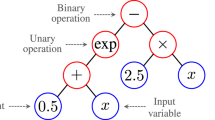Abstract
Uncertainty assessment in basin modeling and reservoir characterization is traditionally treated by geostatistical methods which are normally based on stochastic probabilistic approaches. In this paper, we present an alternative approach which is based on interval arithmetic. Here, we discuss a fnite element formulation which uses interval numbers rather than real numbers to solve the transient heat conduction in sedimentary basins. For this purpose, a novel formulation was developed to deal with both the special interval arithmetic properties and the transient term in the differential Equation governing heat transfer. In this formulation, the “stiffness” matrix resulting from the discretization of the heat conduction equation is assembled with an element-by-element technique in which the elements are globally independent and the continuity is enforced by Lagrange multipliers. This formulation is an alternative to traditional Monte Carlo method, where it is necessary to run a simulation several times to estimate the uncertainty in the results.We have applied the newly developed techniques to a one-dimensional thermal basin simulation to assess their potential and limitations.We also compared the quality of our formulation with other solution methods for interval linear systems of equations.
Similar content being viewed by others
References
Burnett, D. S.: Finite Element Analysis from Concepts to Applications,Addison-Wesley, Whip- pany, 1987.
Deodato, S., Anile, A. M., and Privitera, G.: Implementing Fuzzy Arithmetic, Fuzzy Sets and Systems72 (1995), pp. 239–250.
Hansen, E. R.: The Hull of Preconditioned Interval Linear Equations, Reliable Computing 6(2) (2000), pp. 95–103.
Hanss, M.: On the Implementation of Fuzzy Arithmetical Operations for Engineering Problems, in: Proceedings of the 8th International Conference of the North American Fuzzy Information Processing Society-NAFIPS 99,New York, 1999, pp. 462 66.
Kaufman, A. and Gupta, M.: Introduction to Fuzzy Arithmetic,International Thomson Computer Press, 1991.
Kulpa, Z., Pownuk, A., and Skalna, I.: Analysis of Linear Mechanical Structures with Uncertain ties by Means of Interval Methods, Computer Assisted Mechanics and Engineering Sciences 5 (1998), pp. 443–477.
McKenzie, D.: Some Remarks on the Development of Sedimentary Basins, Earth Planet. Sci.Left 40 (1978), pp. 25–32.
Mello, U. T.: Thermal and Mechanical History of Sediments in Extensional Basins,Ph.D. dis sertation, Columbia University, 1994.
Mello, U. T. and Karner, G. D.: Development of Sediment Overpressure and Its Effect on Thermal Maturation: Application to the Gulf of Mexico Basin, American Association of Petroleum Geologists Bulletin80 (9) (1996), pp. 1367–1396.
Mello, U. T., Karner, G. D., and Anderson, R. N.: A Physical Explanation for the Positioning of the Depth to the Top of Overpressure in Shale-Dominated Sequences in the Gulf Coast Basin, United States, Journal of Geophysical Research99 (1994), pp. 2775–2789.
Mello, U. T. and Khabibrakhmanov, I.: On the Reusability and Numeric Efficiency of C++ Packages in Scientific Computing, in: Proceeding of the ClusterWorld Conference and Expo, June 23–26, 2003 in San Jose, California,2003.
Moore, R. E.: Interval Arithmetic and Automatic Error Analysis in Digital Computing,Stanford University, 1962.
Muhanna, R., Ballarini, R., and Mullen, R.: Calculation of Stress Intensity Factors with Fuzzy Loading, in: Proceedings of the 4th International Conference on Stochastic Structural Dynamics,University of Notre Dame, Notre Dame, 1998, pp. 6–8.
Muhanna, R. L. and Mullen, R. L.: Development of Interval Based Methods for Fuzziness in Continuum Mechanics, in: Proc. ISUMA-NAFIPS’95, September 17–20, 1995,pp. 145–150.
Muhanna, R. L. and Mullen, R. L.: Formulation of Fuzzy Finite Element Methods for Mechanics Problems, Computer-Aided Civil and Infrastructure Engineering(previously Microcomputers in Civil Engineering)14 (1999), pp. 107–117.
Muhanna, R. L. and Mullen, R. L.: Sharp Enclosure for Material Uncertainty in Solid and Structural Mechanics-Interval Based Approach, Part I, in: Proceedings of the Eighth ASCE Joint Specialty Conference on Probabilistic Mechanics and Structural Reliability,University of Notre Dame, Notre Dame, 2000, pp. 24–26.
Muhanna, R. L. and Mullen, R. L.: Treatment of Geometric Tolerances in Finite Element Analysis, International Journal of Advanced Manufacturing Systems4(1) (2001), pp. 143–162.
Muhanna, R. L. and Mullen, R. L.: Uncertainty in Mechanics Problems—Interval-Based Approach, Journal of Engineering Mechanics, ASCE127 (6) (2001), pp. 557–566.
Mullen, R. L. and Muhanna, R. L.: Bounds of Structural Response for All Possible Loadings, Journal of Structural Engineering, ASCE125 (1) (1999), pp. 98–106.
Mullen, R. L. and Muhanna, R. L.: Interval Based Finite Element Methods, in: Iliev, O. P. and Kaschiev, M. S. (eds), Proceedings of the 4-th International Conference, NMA’98, Recent Advances in Numerical Methods and Applications II, Aug. 19–23,World Scientific, 1998, pp. 362–371.
Mullen, R. L. and Muhanna, R. L.: Interval-Based Geometric and Material Uncertainty for Mechanics Problems, in: Proceedings of the 13th ASCE Engineering Mechanics Division Con ference,The Johns Hopkins University, Baltimore, 1999, pp. 13–16.
Mullen, R. L. and Muhanna, R. L.: Structural Analysis with Fuzzy-Based Load Uncertainty, in: Proc, 7th ASCE EMD/STD Joint Specialty Conference on Probabilistic Mechanics and Structural Reliability,WPI, pp. 310–313.
Mullen, R. L. and Muhanna, R. L.: Sharp Interval Estimates for Finite Element Solutions with Fuzzy Material Properties, in: Proceedings of the 14th ASCE Engineering Mechanics Conference,The University of Texas at Austin, 2000, pp. 21–24.
Nakagiri, S. and Suzuki, K.: Finite Element Interval Analysis of External Loads Identified by Displacement Input Uncertainty, Comput. Methods Appl. Mech. Engrg.168 (1999), pp. 63–72.
Neumaier, A.: Interval Methods for Systems of Equations,Cambridge University Press, New York, 1990.
Neumaier, A.: Overestimation in Linear Interval Equations, SIAM J. Numerical Analysis24 (1) (1987), pp. 207–214.
Rao, S. S. and Berke, L.: Analysis of Uncertain Structural Systems Using Interval Analysis, AIAA Journal35 (4) (1997), pp. 727–735.
Rao, S. S. and Li Chen: Numerical Solution of Fuzzy Linear Equations In Engineering Analysis, Int. J. Numer. Meth. Eng.43 (1998), pp. 391–408.
Rao, S. S. and Sawyer, P.: Fuzzy Finite Element Approach for Analysis of Imprecisely Denned Systems, AIAA Journal33 (12) (1995), pp. 2364–2370.
Rump, S. M.: Rigorous Sensitive Analysis for Systems of Linear and Nonlinear Equations, Math. of Computations 54(90) (1990), pp. 721–736.
Author information
Authors and Affiliations
Corresponding author
Rights and permissions
About this article
Cite this article
Pereira, S.C., Mello, U.T., Ebecken, N.F.F. et al. Uncertainty in Thermal Basin Modeling: An Interval Finite Element Approach. Reliable Comput 12, 451–470 (2006). https://doi.org/10.1007/s11155-006-9014-5
Received:
Accepted:
Published:
Issue Date:
DOI: https://doi.org/10.1007/s11155-006-9014-5



